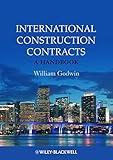International construction contracts : a handbook : with commentary on the FIDIC design-build forms / William Godwin.
Material type: TextPublisher: Chichester, West Sussex, UK ; Ames, Iowa : Wiley-Blackwell, 2013Description: 1 online resourceContent type:
TextPublisher: Chichester, West Sussex, UK ; Ames, Iowa : Wiley-Blackwell, 2013Description: 1 online resourceContent type: - text
- computer
- online resource
- 9781118498460
- 1118498461
- 9781118498477
- 111849847X
- 9781118498606
- 1118498607
- 9781118498590
- 1118498593
- 0470655720
- 9780470655726
- 9781299158887
- 1299158889
- 692/.8 23
- K891.B8
- LAW019000
"The book provides clear, concise and practical guidance on the understanding, negotiation and management of contracts for international construction and engineering projects. It covers, in a simple and straightforward way, the main features of construction contracts, the underlying notions on which they are based and the various dispute resolution procedures available should a dispute arise, with the aim of ensuring the construction professional (engineer or other non-lawyer) engaged on an international project has an awareness of the types of issue that typically arise on the contractual side of the project"-- Provided by publisher.
"The book provides clear, concise and practical guidance on the understanding, negotiation and management of contracts for international construction and engineering projects"-- Provided by publisher.
Includes bibliographical references and index.
Machine generated contents note: Foreword Preface About the Author Acknowledgments PART ONE Chapter 1 CONTRACTS I. What is a Contract? 1. A working definition 2. Agreement 3. Do contracts need to be in writing? 4. Other elements of a contract 5. Capacity and authority 6. Importance of a written contract 7. What should a properly written construction contract cover? 8. Tailoring the contract Chapter 2 Risk 9. How risk may be allocated 10. The 'traditional' approach to risk 11. EPC/turnkey projects 12. BOT-type projects 13. Parties to a BOT-type project 14. Contracts involved in a BOT-type project 15. The FIDIC Silver Book 16. Particular Risks: the Unforeseen and Design Chapter 3 Types of Construction Contract 17. Lump sum contracts 18. Prime cost or reimbursable contracts 19. Unit price contracts 20. Target contracts 21. Which contract? PART TWO Chapter 4 The FIDIC Design-Build Contracts 22. Some key general provisions 23. The Employer 24. Contract Administration and the role of the Engineer 25. The Contractor 26. Design 27. Staff and Labour 28. Plant, Materials and Workmanship 29. Time: Commencement, Delays and Suspension of the Works 30. Tests on Completion 31. Employer's Taking Over 32. Defects Liability 33. Tests after Completion 34. Variations and adjustments to the contract price 35. Payment 36. Termination by the Employer 37. Suspension and Termination by the Contractor 38. Risk and Responsibility 39. Insurance 40. Force Majeure 41. Contractor's claims, disputes, and arbitration PART THREE Chapter 5 Disputes and How to Resolve Them 42. Introduction 43. Legal Aspects of a Construction Project 44. Kinds of Claim 45. Making a Claim 46. Who decides whether to accept a claim? 47. Dispute Review Boards and the FIDIC DAB 48. Methods of Dispute Resolution 49. Arbitration 50. How are International Arbitrations conducted? APPENDIX I Yugo Design Company v Sino Industries Corporation: an ICC Arbitration from Start to Finish APPENDIX II Rules of Arbitration of the International Chamber of Commerce Rules of Arbitration of the Singapore International Arbitration Centre Index.
Print version record and CIP data provided by publisher.
International Construction Contracts: A Handbook; Copyright; Contents; Preface; Foreword; Acknowledgements; About the Author; Part I; 1 Contract; 1.1 What is a contract?; 1.2 Agreement; 1.3 Do contracts need to be in writing?; 1.4 Other elements of a contract; 1.5 Capacity and authority; 1.6 Importance of a written contract; 1.6.1Clarity and certainty; 1.6.2Procedures; 1.6.3Risk allocation; 1.7 What should a properly written construction contract cover?; 1.7.1 FIDIC contracts; 1.7.2Programme; 1.7.3Delays and extensions of time; 1.7.4Delay damages; 1.8 Tailoring the contract; 2 Risk.
2.1 How risk may be allocated2.2 The 'traditional' approach to risk; 2.3 EPC/turnkey projects; 2.4 BOT-type projects; 2.4.1 Parties to a BOT-type project; 2.4.2 Contracts involved in a BOT-type project; 2.5 The FIDIC Silver Book; 2.6 Particular risks: The unforeseen and design; 2.6.1Unforeseeable physical conditions; 2.6.2Design responsibility; 3 Types of Construction Contract; 3.1 Lump sum contracts; 3.2 Prime cost or reimbursable contracts; 3.3 Unit price contracts; 3.4 Target contracts; 3.5 Which contract?; Part II; 4 The FIDIC Design-Build Contracts; 4.1 Some key general provisions.
4.1.1 Communications: Clause 1.34.1.2 The law and the language of the contract: Clause 1.4; 4.1.3 The priority of documents: Clause 1.5; 4.1.4 Compliance with laws: Clause 1.13; 4.2 The Employer; 4.2.1 The right of access to, and possession of, the site: Clause 2.1; 4.2.2 Evidence of the Employer's financial arrangements: Clause 2.4; 4.2.3 Employer's claims against the Contractor: Clause 2.5; 4.3 Contract administration: Clause 3; 4.3.1 The role of the Engineer; 4.3.2 'Determinations' in the Yellow and Silver Books; 4.3.3 Employer's Representative in the Silver Book.
4.3.4 The giving of instructions4.4 The Contractor; 4.4.1 The Contractor's general obligation: Clause 4.1; 4.4.2 'The works' which must fit the intended purpose: Clause 4.1; 4.4.3 Securing performance: Clause 4.2; 4.4.4 Contractor's Representative: Clause 4.3; 4.4.5 Subcontracting: Clauses 4.4 and 4.5; 4.4.6 Setting out: Clause 4.7; 4.4.7 Sufficiency of the Contract Price (Silver Book) or Accepted Contract Amount (Yellow Book): Clause 4.11; 4.4.8 Unforeseeable difficulties/physical conditions: Clause 4.12; 4.4.9 Progress reports: Clause 4.21; 4.5 Design.
4.5.1 The Contractor's general design obligations (Yellow and Silver Books): Clause 5.14.5.2 Contractor's documents: Clause 5.2; 4.5.3 Contractor's undertaking: Clause 5.3; 4.6 Staff and labour: Clause 6; 4.7 Plant, materials and workmanship; 4.7.1 Executing the works: Clause 7.1; 4.7.2 Samples: Clause 7.2; 4.7.3 Inspections: Clause 7.3; 4.7.4 Testing: Clause 7.4; 4.7.5 Rejection and remedial work: Clauses 7.5 and 7.6; 4.7.6 Ownership: Clause 7.7; 4.8 Time: commencement, delays and suspension of the works; 4.8.1 Commencement and time for completion of the works: Clauses 8.1 and 8.2.
Media and Communication
